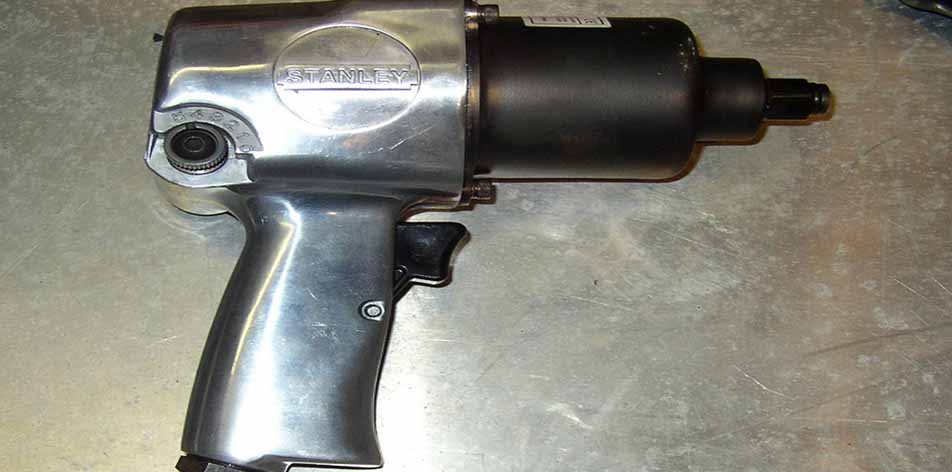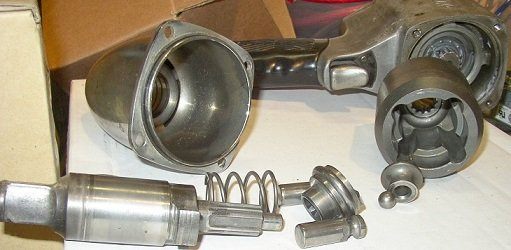

In a separate article, we examined the differences between an impact wrench and an impact driver. For most home and automotive uses, do it yourselfers can get away with an impact driver. For stouter professional applications, such as driving or loosening large bolts or fastening larger materials, an impact wrench is the tool of choice. Impact wrenches come in several varieties, including best cordless wrench and battery powered versions.
A traditional impact wrench, the one common to mechanics and auto body shops, is a pneumatic impact wrench. (Pneumatic impact wrenches may also be called an impact gun or air wrench). This article will attempt to answer the question: How do pneumatic impact wrenches work?
View lists of top Pneumatic Impact Wrenches.
Click here if need know differences between Air tool or Power tool and which to use for projects.
How do Pneumatic Impact Wrenches Get Their Power?
One of the more interesting features of a pneumatic impact wrench is the source of its power. Pneumatic impact wrenches are powered by compressed air, usually via a portable compressed air tank or an air compressor.
There are several different designs for pneumatic air wrenches; what follows it the most common. The compressed air passes through a vane motor – which looks a bit like a box fan — and can be lubricated in several different ways.
In most cases, the motor directly turns a hammer assembly through a fixed anvil. The anvil is designed to stop the hammer periodically, e.g. every half turn, through a series of spring loaded ball ramps that push clutches outward to stop the rotating hammer. Flowing air passes through the vane motor and is then directed out the back of the impact wrench.
What are Other Types of Pneumatic Impact Wrench Design?
[tcb-script async=”” src=”//pagead2.googlesyndication.com/pagead/js/adsbygoogle.js”][/tcb-script][tcb-script](adsbygoogle = window.adsbygoogle || []).push({});[/tcb-script] [tcb-script type=”text/javascript”]amzn_assoc_placement = “adunit0”;amzn_assoc_search_bar = “true”;amzn_assoc_tracking_id = “sale05be-20”;amzn_assoc_ad_mode = “manual”;amzn_assoc_ad_type = “smart”;amzn_assoc_marketplace = “amazon”;amzn_assoc_region = “US”;amzn_assoc_title = “Air Compressors for your Pneumatic Tools”;amzn_assoc_asins = “B073VB41W3,B07789PTPG,B01L9WSTEG,B00006FRPJ”;amzn_assoc_linkid = “dbcde123fb7345080453b38e5994d71a”;[/tcb-script][tcb-script src=”//z-na.amazon-adsystem.com/widgets/onejs?MarketPlace=US”][/tcb-script]
While trying to avoid becoming too technical, other wrenches are designed to deliver varying degrees of torque at different speeds. As a result, some pneumatic impact wrench designs use a system of gear reduction; in such cases, the motor turns gears which, in turn drive the rotating hammer.
Most commonly, the hammer is heavier than in the standard design described in the section above. The advantage of this design is that the gear systems deliver can greater torque while turning at more consistent speeds.
How Much Compressor Does it Need?
If you decide that you absolutely must have a pneumatic air wrench (more on that in a bit), you’ll have to determine the best method to deliver compressed air. Your choices will be a portable air tank or a compressor. The portable air tank holds a finite amount of air, so is only of any use for short applications.
Portable compressors are readily available, so finding one is probably your best option. To determine the appropriate sized compressor, you’re going to have to do a bit of math. Find the rating of your wrench in both CFM (cubic feet per minute) and PSI (pounds per square inch). Let’s say your wrench requires, say, 4 CFM, at 90 PSI.
To find a working CFM range, you’ll need to multiply by 1.25 and 1.5. In this case, you’ll need a compressor that can deliver 5 to 6 CFM at 90 PSI. Note: be sure to compare flow rates using the same PSI rating.
What are the Advantages of a Pneumatic Impact Wrench?
[tcb-script async=”” src=”//pagead2.googlesyndication.com/pagead/js/adsbygoogle.js”][/tcb-script][tcb-script] (adsbygoogle = window.adsbygoogle || []).push({});[/tcb-script] [tcb-script type=”text/javascript”]amzn_assoc_placement = “adunit0”;amzn_assoc_search_bar = “true”;amzn_assoc_tracking_id = “sale05be-20”;amzn_assoc_search_bar_position = “bottom”;amzn_assoc_ad_mode = “search”;amzn_assoc_ad_type = “smart”;amzn_assoc_marketplace = “amazon”;amzn_assoc_region = “US”;amzn_assoc_title = “Shop Related Products”;amzn_assoc_default_search_phrase = “air compressor accessories”;amzn_assoc_default_category = “Automotive”;amzn_assoc_linkid = “1f2cf1cb996286f7e8470f5088098347”;amzn_assoc_default_browse_node = “15684181”;[/tcb-script][tcb-script src=”//z-na.amazon-adsystem.com/widgets/onejs?MarketPlace=US”][/tcb-script]
The greatest advantage of a pneumatic impact wrench, and impact wrenches in general, is in their application of force. Think about turning a drill bit with a standard drill. The trigger engages the motor, which, after an initial jolt, turns the bit with a steady application of torque.
Now, consider the circumstance of trying to remove a rusted lug nut from a car tire. Sometimes, steady torque just doesn’t cut it. Instead, you attach a socket, greatly increase the lever arm with a length of pipe, then hit the end of the pipe with a hammer, using short, powerful strikes.
This is, in essence, the effect of a pneumatic impact wrench. The clutches that stop the rotating hammer have the effect of delivering short, powerful bursts of torque, essential for some heavy-duty applications.
Is a Pneumatic Impact Wrench Right for Me?
You may want to read this interesting blog to know should you use pneumatic tools or non air tools, so click here. And we also have selected top rated Pneumatic tools reviewed, click here to see the updated lists. Pneumatic impact wrenches can be fitted with an adapter for driving small screws. Even so, it’s probably overkill for most people. On the other hand, f you need huge amounts of power, drive and remove large bolts, and do so through the metal, an impact wrench may be the best tool for you. But only if this is something you do repeatedly.
For most non-professionals, an impact wrench may be worth the cost if rebuilding, say, a 1967 Ford Fairlane in the garage. If not, a pneumatic air wrench is, in all likelihood, unnecessary; you’re probably better off with an impact driver. In fact, most impact drivers can be fitted with an adapter to do the job of a pneumatic impact wrench, just on a much smaller scale.
Conclusion
[tcb-script async=”” src=”//pagead2.googlesyndication.com/pagead/js/adsbygoogle.js”][/tcb-script][tcb-script] (adsbygoogle = window.adsbygoogle || []).push({});[/tcb-script]
This article sought to explain the inner workings of a pneumatic impact wrench for a lay person and describe its basic uses. We certainly hope you found the information useful and entertaining. If you would like to add anything to our description, or think we should change anything please let us know in the comments below.
Now, as always, we’re committed to simplifying the world of home improvement and helping consumers navigate the complex world of power tools: if you think anybody would benefit from this article, please feel free to share. Thanks for reading!
